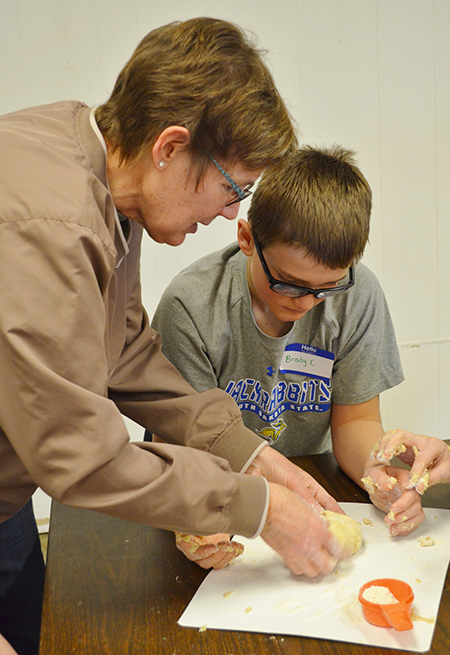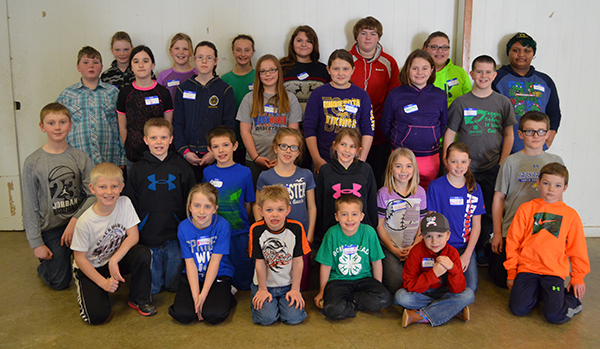
Tina Kieffer, Administrative Assistant from Aurora County, works with Brady Larson as he kneads his bread dough.
It’s one of the first lessons in culinary school: baking is a science. Any minor changes in a recipe, like t
oo much baking powder, or melted versus softened butter, can make a huge difference between a great cookie or a mess, explained Audra Scheel, SDSU Extension 4-H Youth Program Advisor. On Feb. 12, Jerauld County 4-H hosted a food science workshop for local 4-H members within the four
county area at the 4-H Ag Building in Wessington Springs.
Youth were divided up in teams to conduct a cookie science experiment. Each team was given a chocolate chip cookie recipe that was slightly different from the ne
xt team, such as baking soda swapped out with baking powder. After each team’s cookies were baked, the youth put on their food scientist hats and evaluated their work while ranking cookies based on taste, appearance and texture.
South Dakota 4-H has four mission mandates: Ag-Vocacy, Leadership, Healthy Relationships, and STEM. STEM stands for science, technology, engineering and math.
“Science and math are everywhere, and when we can translate that to current 4-H projects such as Foods and Nutrition, we are helping link and connect science to our everyday world that ordinarily may be hard for youth to see,” said Scheel. Twenty-eight youth attended the workshop to discover the science behind baking. The focus was on gaining basic cooking skills such as measuring correctly and how to correctly crack an egg.
Youth were also able to try their hand at baking bread, as well. A simple ‘bread in a bag’ recipe was used, and the children learned how to properly knead bread dough. “Yeast is really quite interesting. As the rapid eating and digestion cycle occurs, gas bubbles are released and, thus, the bread dough ‘rises’. The gluten in the bread allows the dough to stretch, trapping those gas bubbles and making air pockets in the dough,” said Scheel. Each child was able to bake a mini loaf of bread.
Members of 4-H may exhibit many different food items at their local Achievement Days and the South Dakota State Fair, including yeast breads, quick breads, muffins and cookies. There is also food preservation and food safety project areas. The youth in action component is called the Special Foods Contest, where youth can cook a main dish in front of a judge, test their nutrition knowledge and learn how to properly set a dining table. If your child is interested in becoming a 4-H member, contact your local SDSU Extension office or e-mail audra.scheel@sdstate.edu.

Group picture from the four county (Aurora, Buffalo, Jerauld, Sanborn) 4-H Cookie Science & Bread Baking Workshop on Feb. 12: front row, left to right: Bryce Larson, Kerstynn Heim, Teagan Bush, Teagan Scheel, Rylan Fagerhaug, Keaton Fridley; second row: Evan Bultsma, Rylan Bush, Karter Mebius, Masynn Mebius, Addyson Orth, Raylee Fagerhaug, Hannah Heezen, Brady Larson; third row: Henry Hunter, Sarah Poncelow, Alexis Kelly, Kenlie Fridley, Harlee Heim, Delaney Zoss, TJ Harris; back row: Breann Schabot, Avery Orth, Carissa Scheel, Nicole Inch, Robert Inch, Lilianna Ziegler, Tache’ Nelson.

Tweet